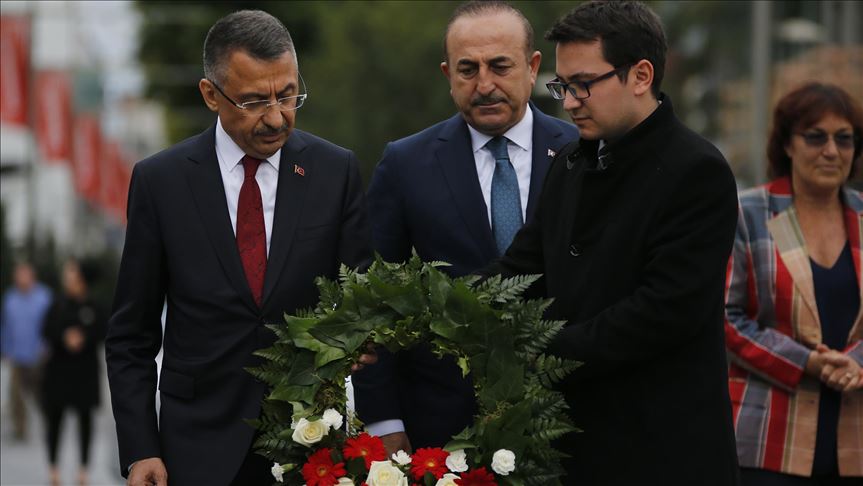Turkish VP marks Canakkale naval victory of 1915
1915 naval battles in Canakkale Campaign were fought between February and March, ended in victory for Ottoman Turkish forces
 Vice President of Turkey, Fuat Oktay (L) and Turkish Foreign Minister Mevlut Cavusoglu (C)
Vice President of Turkey, Fuat Oktay (L) and Turkish Foreign Minister Mevlut Cavusoglu (C)
CHRISTCHURCH, New Zealand
Turkish vice president on Monday commemorated the fallen soldiers who lost their lives during naval and ground battles in Canakkale during WWI.
"The conditions in which we are living 100 years later show that the world has failed to learn lessons from the two great wars," Fuat Oktay said.
The naval battles in the Canakkale Campaign were fought between February 19 and March 18, 1915, which ended in a victory for the Ottoman Turkish forces.
The failure of the British-French plan eventually led to the ground battles in the Gallipoli Campaign in April 1915 which also involved divisions of the Australian and New Zealand Army Corps, or ANZAC.
Oktay and Turkish Foreign Minister Mevlut Cavusoglu were on a two-day visit to Christchurch, New Zealand, after the twin terror attacks on two mosques that killed at least 50 Muslim worshippers.
Oktay and Cavusoglu laid a wreath during a commemoration ceremony on the Bridge of Remembrance in Christchurch, which is dedicated to the ANZACs who died in WWI.
Also attending the ceremony Patsy Reddy, New Zealand's governor-general, said New Zealand and Turkey have no problems in their relations.
The events leading up to the momentous battle started in February 1915, when Britain and France decided to launch the Gallipoli Campaign to knock the Ottoman Empire out of the war as quickly as possible by reaching and capturing its capital, Istanbul.
They started their attack on March 18 -- the day, which is commemorated today as the Canakkale Naval Victory Day -- but the waters were filled with a network of mines laid by Ottoman vessels.
On April 25, allied soldiers landed on the shores of the Gallipoli peninsula. The troops were there as part of a plan to open the Canakkale Strait on Turkey's Aegean coast to Allied fleets, allowing them to threaten the Ottoman capital.
The Allied forces, however, encountered strong and courageous resistance from the Turks and the campaign turned out to be a costly failure.
Tens of thousands of Turkish nationals and soldiers died, along with tens of thousands of Europeans, plus around 7,000 - 8,000 Australians and nearly 3,000 New Zealanders, referred together as Anzac troops.
Victory against the Allied forces boosted the morale of the Turkish side, who then went on to wage a war of independence between 1919 and 1922, and eventually formed a republic in 1923 from the ashes of the old empire.
*Writing by Erdogan Cagatay Zontur
Anadolu Agency website contains only a portion of the news stories offered to subscribers in the AA News Broadcasting System (HAS), and in summarized form. Please contact us for subscription options.






